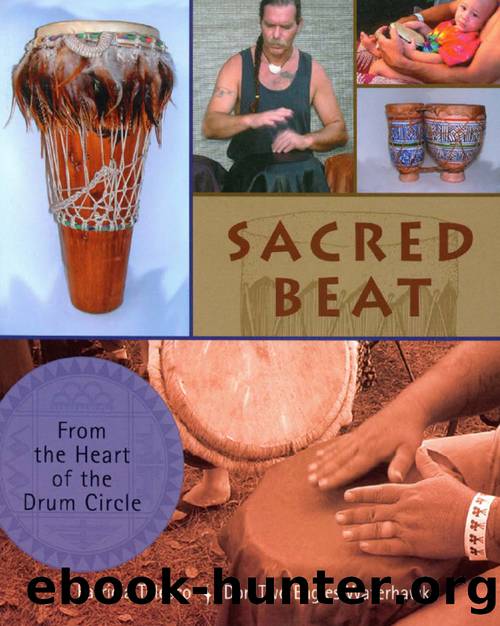Sacred Beat by Patricia Telesco

Author:Patricia Telesco
Language: eng
Format: epub
Publisher: Red Wheel Weiser
THE ROLE OF COSTUME
For dance, I pick clothing that is specific to the ritual or sacred space in which I am dancing, but there are practical considerations too. How close is the fire, what's the condition of the ground? Safety still comes first.
âRakasha
Our ancestors wore masks and other costumes to inspire those watching the dance. By putting on the mask of an ancestor or spirit, and calling on that power, he or she became a mythic, legendary being. Kachina dancers are like this among the Hopi, where the dancers become secondary to the ancestral energies they represent. The Semesi masks of New Guinea are similarâeach creating a connection between the dancer and the spirit depicted by the mask and garb.
The impact this had on participants at a circle should not be underestimated. A simple mask can give both dancer and audience the ability to suspend disbelief and accept what is happening. Seeing is, indeed, believing very frequently to the human mind. This is the whole reason we use costume in the theater, TV, and in magical practices to this day. Our mind has the capacity to imagine and believe. And it is in those moments that real magic happens.
No matter where you look in both sacred and secular dance, costumes are there as helpmates. The key is finding the right pieces for the task at hand. At outdoor gatherings in particular, where you'll be dancing at a bonfire, you don't want to wear things highly flammable. While you want your dance to light up faces, let's avoid literal ignition! Similarly, if it's very cold, icy, or other poor weather conditions exist, please take safety into account in both costume and foot ware. Spiritual considerations are important, but they won't do you much good with a twisted ankle or if you end up sick from exposure.
Now that the parental advice is out of the way, we can look at three considerations for costumes in community-oriented sacred dancing. First, ask yourself the theme of the event and pattern your costume accordingly. If it's spring, light, airy costumes really accentuate the liberating energies and air element in this season, for example. Or, a gathering dedicated to the spirit of love might be well served with red, pink, and purple-toned costumes, the colors that motivate love.
Second, consider the costume's design. Can you move comfortably? Is your field of vision broad enough (if wearing a mask)? Does the costume evoke the imagery you want? This is particularly important if you're going to dance with any spirits as partners, as the costume honors that spirit and helps participants connect with the energies.
SOME EXAMPLES OF THE ROLE OF COSTUME
Australian custom dictates dancing in colorful costumes and wearing scary wooden masks on January 8 and 9. This festival, called the Dance of the Phantoms, drives away evil spirits and blesses the grain for the coming year.
Malayan villagers danced wearing masks to bring their lives back into balance after someone died. Most often these depicted trees, animals, or hunters.
Download
This site does not store any files on its server. We only index and link to content provided by other sites. Please contact the content providers to delete copyright contents if any and email us, we'll remove relevant links or contents immediately.
Kathy Andrews Collection by Kathy Andrews(11323)
The remains of the day by Kazuo Ishiguro(8393)
Paper Towns by Green John(4797)
Spare by Prince Harry The Duke of Sussex(4786)
Industrial Automation from Scratch: A hands-on guide to using sensors, actuators, PLCs, HMIs, and SCADA to automate industrial processes by Olushola Akande(4599)
The Body: A Guide for Occupants by Bill Bryson(4583)
Be in a Treehouse by Pete Nelson(3647)
Machine Learning at Scale with H2O by Gregory Keys | David Whiting(3621)
Harry Potter and the Goblet Of Fire by J.K. Rowling(3608)
Never by Ken Follett(3523)
Goodbye Paradise(3446)
The Remains of the Day by Kazuo Ishiguro(3136)
Into Thin Air by Jon Krakauer(3131)
The Cellar by Natasha Preston(3077)
The Genius of Japanese Carpentry by Azby Brown(3038)
Fairy Tale by Stephen King(2946)
Drawing Shortcuts: Developing Quick Drawing Skills Using Today's Technology by Leggitt Jim(2939)
120 Days of Sodom by Marquis de Sade(2938)
The Man Who Died Twice by Richard Osman(2807)
